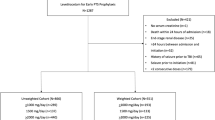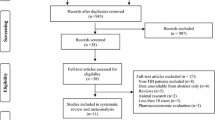Abstract
Introduction
Early seizures after severe traumatic brain injury (TBI) have a reported incidence of up to 15 %. Prophylaxis for early seizures using 1 week of phenytoin is considered standard of care for seizure prevention. However, many centers have substituted the anticonvulsant levetiracetam without good data on the efficacy of this approach. Our hypothesis was that the treatment with levetiracetam is not effective in preventing early post-traumatic seizures.
Methods
All trauma patients sustaining a TBI from January 2007 to December 2009 at an urban level-one trauma center were retrospectively analyzed. Seizures were identified from a prospectively gathered morbidity database and anticonvulsant use from the pharmacy database. Statistical comparisons were made by Chi square, t tests, and logistic regression modeling. Patients who received levetiracetam prophylaxis were matched 1:1 using propensity score matching with those who did not receive the drug.
Results
5551 trauma patients suffered a TBI during the study period, with an overall seizure rate of 0.7 % (39/5551). Of the total population, 1795 were diagnosed with severe TBI (Head AIS score 3–5). Seizures were 25 times more likely in the severe TBI group than in the non-severe group [2.0 % (36/1795) vs. 0.08 % (3/3756); OR 25.6; 95 % CI 7.8–83.2; p < 0.0001]. Of the patients who had seizures after severe TBI, 25 % (9/36) received pharmacologic prophylaxis with levetiracetam, phenytoin, or fosphenytoin. In a matched cohort by propensity scores, no difference was seen in seizure rates between the levetiracetam group and no-prophylaxis group (1.9 vs. 3.4 %, p = 0.50).
Conclusions
In this propensity score-matched cohort analysis, levetiracetam prophylaxis was ineffective in preventing seizures as the rate of seizures was similar whether patients did or did not receive the drug. The incidence of post-traumatic seizures in severe TBI patients was only 2.0 % in this study; therefore we question the benefit of routine prophylactic anticonvulsant therapy in patients with TBI.

Similar content being viewed by others
References
Centers for Disease Control and Prevention, National Center for Injury Prevention and Control: “Traumatic Brain Injury”. http://www.cdc.gov/TraumaticBrainInjury/index.html
Temkin NR (2009) Preventing and treating posttraumatic seizures: the human experience. Epilepsia 50(Suppl 2):10–13
Szaflarski JP, Sangha KS, Lindsell CJ, Shutter LA (2010) Prospective, randomized, single-blinded comparative trial of intravenous levetiracetam versus phenytoin for seizure prophylaxis. Neurocrit Care 12:165–172
Stratton SC, Large CH, Cox B, Davies G, Hagan RM (2003) Effects of lamotrigine and levetiracetam on seizure development in a rat amygdala kindling model. Epilepsy Res 53:95–106
Temkin NR, Dikmen SS, Wilensky AJ, Keihm J, Chabal S, Winn HR (1990) A randomized, double-blind study of phenytoin for the prevention of post-traumatic seizures. The New England Journal of Medicine 323:497–502
Brain Trauma F (2007) American Association of Neurological S, Congress of Neurological S. Guidelines for the management of severe traumatic brain injury. J Neurotrauma 24(Suppl 1):S1–S106
McQueen JK, Blackwood DH, Harris P, Kalbag RM, Johnson AL (1983) Low risk of late post-traumatic seizures following severe head injury: implications for clinical trials of prophylaxis. J Neurol Neurosurg Psychiatry 46:899–904
Frend V, Chetty M (2007) Dosing and therapeutic monitoring of phenytoin in young adults after neurotrauma: are current practices relevant? Clin Neuropharmacol 30:362–369
Haltiner AM, Newell DW, Temkin NR, Dikmen SS, Winn HR (1999) Side effects and mortality associated with use of phenytoin for early posttraumatic seizure prophylaxis. J Neurosurg 91:588–592
Cotton BA, Kao LS, Kozar R, Holcomb JB (2011) Cost-utility analysis of levetiracetam and phenytoin for posttraumatic seizure prophylaxis. J Trauma 71:375–379
Pieracci FM, Moore EE, Beauchamp K et al (2012) A cost-minimization analysis of phenytoin versus levetiracetam for early seizure pharmacoprophylaxis after traumatic brain injury. J Trauma Acute Care Surg 72:276–281
Jones KE, Puccio AM, Harshman KJ et al (2008) Levetiracetam versus phenytoin for seizure prophylaxis in severe traumatic brain injury. Neurosurg Focus 25:E3
Kruer RM, Harris LH, Goodwin H et al (2013) Changing trends in the use of seizure prophylaxis after traumatic brain injury: a shift from phenytoin to levetiracetam. J Crit Care 28(883):e9–e13
Inaba K, Menaker J, Branco BC et al (2013) A prospective multicenter comparison of levetiracetam versus phenytoin for early posttraumatic seizure prophylaxis. J Trauma Acute Care Surg 74:766–771 discussion 71-3
Bhullar IS, Johnson D, Paul JP, Kerwin AJ, Tepas JJ 3rd, Frykberg ER (2014) More harm than good: antiseizure prophylaxis after traumatic brain injury does not decrease seizure rates but may inhibit functional recovery. J Trauma Acute Care Surg 76:54–60
Annegers JF, Coan SP (2000) The risks of epilepsy after traumatic brain injury. Seizure J Br Epilepsy Assoc 9:453–457
Caballero GC, Hughes DW, Maxwell PR, Green K, Gamboa CD, Barthol CA (2013) Retrospective analysis of levetiracetam compared to phenytoin for seizure prophylaxis in adults with traumatic brain injury. Hosp Pharm 48:757–761
Temkin NR (2003) Risk factors for posttraumatic seizures in adults. Epilepsia 44(Suppl 10):18–20
Oluwole OS (2011) Incidence and risk factors of early post-traumatic seizures in Nigerians. Brain Inj 25:980–988
Liesemer K, Bratton SL, Zebrack CM, Brockmeyer D, Statler KD (2011) Early post-traumatic seizures in moderate to severe pediatric traumatic brain injury: rates, risk factors, and clinical features. J Neurotrauma 28:755–762
Young B, Rapp RP, Norton JA, Haack D, Tibbs PA, Bean JR (1983) Failure of prophylactically administered phenytoin to prevent late posttraumatic seizures. J Neurosurg 58:236–241
Young KD, Okada PJ, Sokolove PE et al (2004) A randomized, double-blinded, placebo-controlled trial of phenytoin for the prevention of early posttraumatic seizures in children with moderate to severe blunt head injury. Ann Emerg Med 43:435–446
Author information
Authors and Affiliations
Corresponding author
Rights and permissions
About this article
Cite this article
Zangbar, B., Khalil, M., Gruessner, A. et al. Levetiracetam Prophylaxis for Post-traumatic Brain Injury Seizures is Ineffective: A Propensity Score Analysis. World J Surg 40, 2667–2672 (2016). https://doi.org/10.1007/s00268-016-3606-y
Published:
Issue Date:
DOI: https://doi.org/10.1007/s00268-016-3606-y




